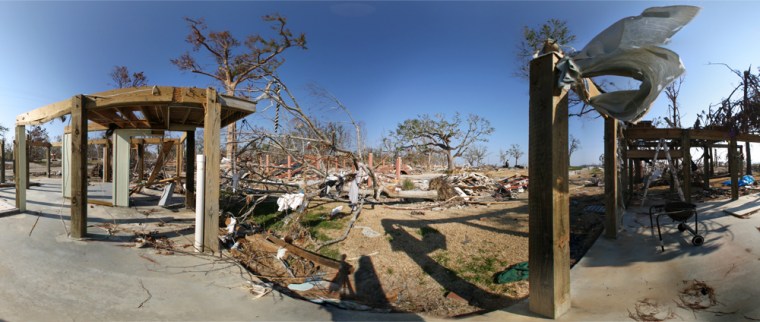As Tropical Storm Chris threatens to strengthen into a hurricane and strike Puerto Rico and the Gulf Coast later this week, residents of a town Hurricane Katrina devastated last August pray for a better year.
“At church every morning, the priest prays for a gentle storm season,” Douglas Niolet, a resident of Bay St. Louis, Miss., said Wednesday. “We pray for peace in Iraq and lots of things, but one of the things we specifically mention is for a gentler or fair storm season since we are so vulnerable.”
So far, it appears their pleas have been heard. But a meteorologist at the National Oceanic and Atmospheric Administration warned the worst has yet to come.
Three named tropical storms — Alberto, Beryl and Chris — have caused minor damage and were indirectly responsible for two deaths since hurricane season began on June 1.
At first glance, it would seem that a mild season is taking shape compared with last year, when at this time eight named storms had already caused up to $7 billion in damage and killed at least 110 people in North America.
But NOAA meteorologist Dennis Feltgen predicted that the number of storms will take off in the coming months. “Don’t let your guard down,” he said.
Philip Klotzbach, a research associate at the Department of Atmospheric Science at Colorado State University, said that historically there are 1.5 named storms in July and August.
That means this year is already above average, and last year was an aberration. The point, Klotzbach said, is “developments in the early months do not say a lot about the full season.”
Moreover, 90 percent to 95 percent of hurricanes brew between August and October, and the season typically peaks around Sept. 10.
‘The question is when’
Niolet recently retired from his job as an aircraft commander who flew into hurricanes to collect weather data. He now spends his days repairing his properties around Mississippi.
In an interview Wednesday, he described a region that has barely begun to rebuild. “Everybody is doing as much as they can,” he said. “There is a lot of anxiety here.”
Many families live in trailers or makeshift houses. Blue tarps still hide roof holes, Niolet said, noting that one medium storm would shred the coverings. “You know there’s going to be another bad storm here. The question is when.”
NOAA forecasters predicted at the end of May that the 2006 season would bring 13 to 16 named storms in the 2006 hurricane season, eight to 10 of those becoming hurricanes and four to six major storms.
Hurricane experts classify major storms as those that are at least Category 3 — with wind speeds exceeding 111 miles per hour. Hurricane Katrina was classified as a Category 5 storm, the highest category, with winds reaching up to 175 miles per hour.
Colorado State University’s Department of Atmospheric Science gave a similar prediction of the 2006 Atlantic hurricane season as NOAA. Both organizations are set to revise their estimates in the coming days.
Feltgen said he “fully expects” this season to be a year of above-average activity.
Historical likelihood of storms
In six of the past 11 hurricane seasons, one or fewer named storms have brewed before Aug. 1. All six of those seasons had at least 12 named storms — and an average of four hurricanes of Category 3 strength after a quiet June and July.
The Atlantic hurricane season officially lasts from June 1 to Nov. 30.
The Atlantic Basin has seen increased hurricane activity since 1995 because of naturally occurring cycles in tropical climate patterns. Experts predict the increased above-average activity could last for another decade or longer.
The record number of hurricanes last year was spawned by warm sea surface temperatures and low wind shear — perfect conditions for the storms.
Feltgen said sea surface temperatures this year are running above normal but cooler than last year. In the 2006 season, there has been some wind shear in the Atlantic Basin, which works against hurricane development.
“This wind shear will ease as we move through August,” Feltgen said.
Alberto, Beryl relatively harmless
Tropical Storm Alberto, the first named hurricane of 2006, formed June 10 and made landfall three days later in the Florida Panhandle.
A storm surge from Alberto flooded Florida towns Crystal River and Cedar Key. The storm weakened in the Carolinas after being blamed indirectly for two deaths.
The second named storm of the season, Tropical Storm Beryl, formed July 18 and stalled off the Eastern Seaboard. In the end, it caused minor damage, including downed telephone and power lines.
